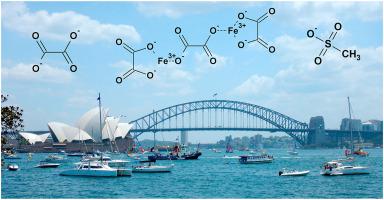Atmospheric Environment ( IF 4.2 ) Pub Date : 2021-09-20 , DOI: 10.1016/j.atmosenv.2021.118739 Hilton B. Swan 1 , John P. Ivey 2

|
In the austral summer period, Dec 7, 2019 to Mar 1, 2020, which included unprecedented bushfire activity, total suspended particulate concentrations of methanesulfonate (MSA), oxalate, labile iron, SO42−, Cl−, Na+, K+, NH4+, water soluble solids (WSS) and water soluble organic carbon (WSOC) were measured from weekly filter samples at Seaforth on the northern edge of Sydney Harbour. Particle number concentrations (PNC) and meteorological conditions were also measured at hourly intervals. These entities were previously measured in the spring-summer period, Sep 30, 2018 to Feb 24, 2019. Data analysis is focussed on inter-comparison between the summer of 2018–19 (S1) and 2019–20 (S2) spanning the period 7 Dec to 24 Feb. During S2 seasonally averaged MSA, oxalate, labile iron, K+, PNC (0.5–2.5 μm), and WSOC were elevated by 102%, 57%, 64%, 72%, 108%, and 1907%, respectively, by comparison to S1. Aqueous phase secondary formation of oxalate and a marine source of MSA were evident during S1; however, during S2 it was indicated that the bushfires created conditions where oxalate formation was shifted away from aqueous phase processing and MSA became associated with bushfire generated WSOC aerosol. Correlation changes at the a = 0.05 significance level between S1 and S2 for MSA, and for oxalate, are examined and discussed in relation to effects apparently caused by the bushfires. It is indicated that the biogeochemical cycling of sulfur and carbon, and particulate deposition of iron micronutrient to the South Pacific Ocean, may be altered by bushfires in Australia.
中文翻译:

2019-20 年澳大利亚夏季空前的丛林大火活动期间,悉尼港上空的甲磺酸盐、草酸盐和铁颗粒升高
在 2019 年 12 月 7 日至 2020 年 3 月 1 日的南方夏季期间,包括前所未有的丛林大火活动、甲磺酸盐 (MSA)、草酸盐、不稳定铁、SO 4 2-、Cl -、Na +、K + 的总悬浮颗粒浓度, NH 4 +、水溶性固体 (WSS) 和水溶性有机碳 (WSOC) 是在悉尼港北部边缘的 Seaforth 每周从过滤器样品中测量的。还每隔一小时测量一次粒子数浓度 (PNC) 和气象条件。这些实体之前在2018年9月30日至2019年2月24日的春夏期间进行了测量。 数据分析侧重于跨越该时期的2018-19夏季(S1)和2019-20(S2)之间的相互比较12 月 7 日至 2 月 24 日。在 S2 期间季节性平均 MSA、草酸盐、不稳定铁、K +与 S1 相比,PNC (0.5–2.5 μm) 和 WSOC 分别提高了 102%、57%、64%、72%、108% 和 1907%。在 S1 期间,草酸盐的水相二次形成和 MSA 的海洋来源很明显;然而,在 S2 期间,表明丛林大火创造了条件,草酸盐的形成从水相处理转移,MSA 与丛林大火产生的 WSOC 气溶胶有关。对 MSA 和草酸盐的 S1 和 S2 之间在a = 0.05 显着性水平上的相关性变化进行了检查和讨论,这些变化与明显由丛林大火引起的影响有关。这表明硫和碳的生物地球化学循环以及铁微量营养素向南太平洋的颗粒沉积可能会被澳大利亚的丛林大火改变。











































 京公网安备 11010802027423号
京公网安备 11010802027423号